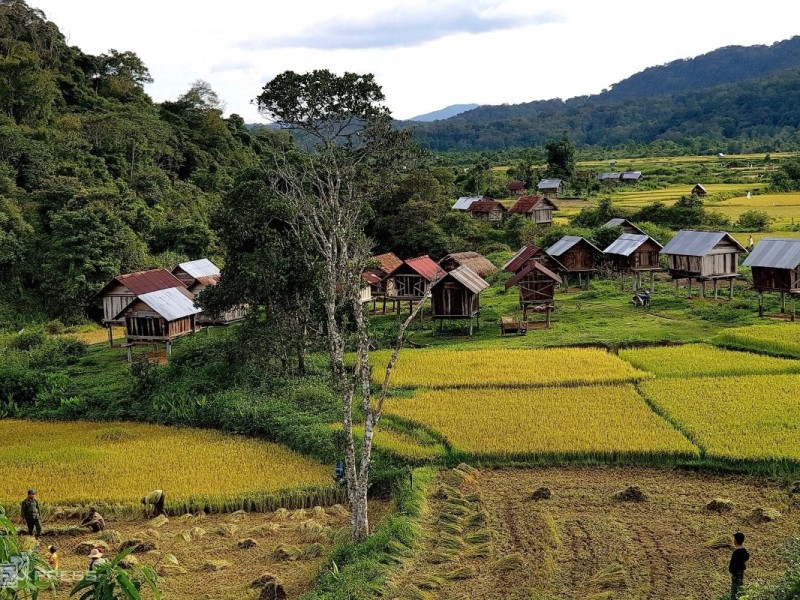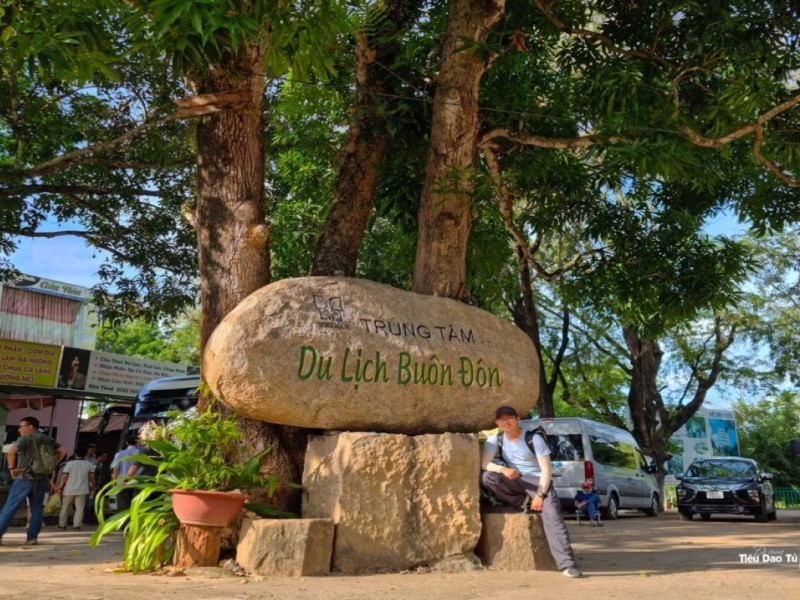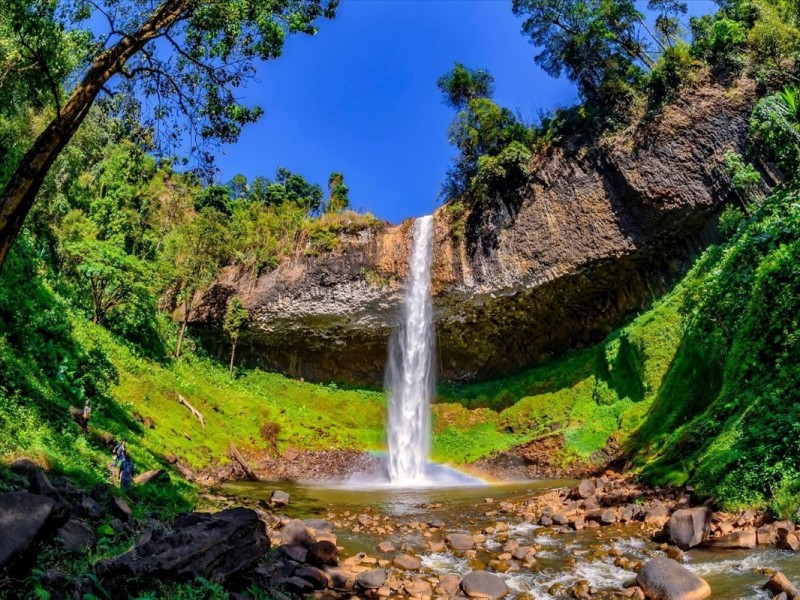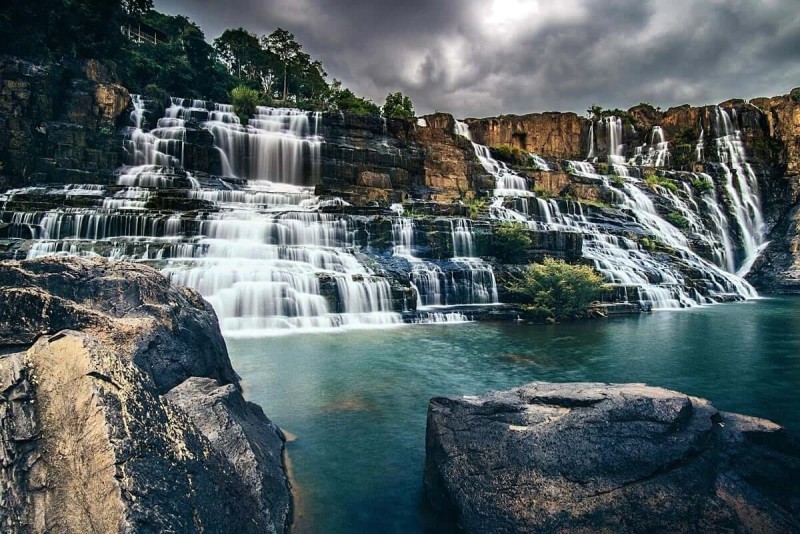Kon Tum Travel Guide: Explore History, Culture, and Nature
Kon Tum Travel Guide provides an insightful look into Vietnam’s Central Highlands, highlighting its rich history, vibrant indigenous cultures, and stunning natural landscapes. Visitors can explore the unique Ba Na villages, trek in Chu Mom Ray National Park, and experience cultural festivals that showcase the region’s heritage and biodiversity.
Overview: Kon Tum Vietnam
Kon Tum is a captivating province located in Vietnam’s Central Highlands, where the borders of Vietnam, Laos, and Cambodia converge. If you’re seeking a destination rich in indigenous culture, lush natural landscapes, and deep history, Kon Tum offers a unique and authentic experience away from typical tourist routes. This overview highlights key facts and features to help you understand why Kon Tum is worth your visit.
- Official Name: Kon Tum Province (Tỉnh Kon Tum)
- Type of Place: Cultural and natural destination; highland province with indigenous villages, national parks, and historical landmarks
- Location: Kon Tum City and surrounding districts, Kon Tum Province, Central Highlands region, Vietnam; borders Laos and Cambodia
- Unique Appeal: A crossroads of Indochina where diverse indigenous cultures, colonial history, and pristine nature converge, offering travelers a rare blend of cultural immersion and eco-adventure
- Outstanding Features:
- The iconic Kon Tum Wooden Church, blending French colonial and Ba Na architectural styles, evokes deep cultural fusion
- The Ba Na indigenous communities preserving traditional stilt houses (rong houses) and UNESCO-recognized Gong Festival music
- Mang Den Ecotourism Area’s cool pine forests, serene lakes, waterfalls, and vibrant cherry blossoms that create a peaceful natural retreat
- Chu Mom Ray National Park’s biodiverse jungles with rare flora and fauna, perfect for trekking and wildlife spotting
- The Dak Bla River winding through scenic landscapes, supporting local life and offering kayaking and river cruises
- How to Get There: Accessible via Pleiku Airport (50 km away) with domestic flights from Ho Chi Minh City, Hanoi, and Da Nang; also reachable by sleeper buses from major cities; local transport includes motorbike rentals and taxis
- Visit Duration: Typically 2 to 4 days to explore key cultural sites, nature reserves, and indigenous villages comfortably
- Best Time to Visit:
- Dry season (November to April) — ideal for trekking, adventure activities, and clear weather
- March — cherry blossom season in Mang Den offers stunning floral landscapes and cultural festivals
- Entry Fee: Most cultural sites like Kon Tum Wooden Church are free; some national parks and eco-tourism areas may charge nominal fees or require tour bookings
- Accessibility: Mostly accessible by road; some trekking areas may be challenging for those with mobility issues; boat access available for river activities
- Top Activities:
- Trekking Ngoc Linh Mountain and Chu Mom Ray National Park for panoramic views and wildlife encounters
- Visiting Ba Na villages to experience traditional rong houses, weaving, and cultural ceremonies
- Attending the Gong Festival or New Rice Festival to witness indigenous music and rituals
- Kayaking and river cruises on the Dak Bla River with cultural performances and village stops
- Exploring Mang Den’s pine forests, lakes, waterfalls, and seasonal cherry blossoms
- Responsible Travel Tip: Respect local customs and traditions, especially when visiting indigenous communities and participating in festivals; always seek permission before photographing people or sacred sites.
- Fun Fact: Kon Tum sits at the unique Indochina Junction where you can stand with one foot in Vietnam, one in Laos, and one in Cambodia—an extraordinary geographical and cultural tripoint.
- Visiting Tips:
- Book accommodations and tours in advance during cherry blossom season to secure your spot.
- Bring sturdy footwear and insect repellent for trekking and forest exploration.
- Learn a few basic Vietnamese or local phrases to connect respectfully with indigenous hosts and enhance your cultural experience.
This concise overview equips you with essential insights to prepare for a memorable journey through the heart of Vietnam’s Central Highlands, where Kon Tum’s vibrant culture and stunning landscapes await your discovery.
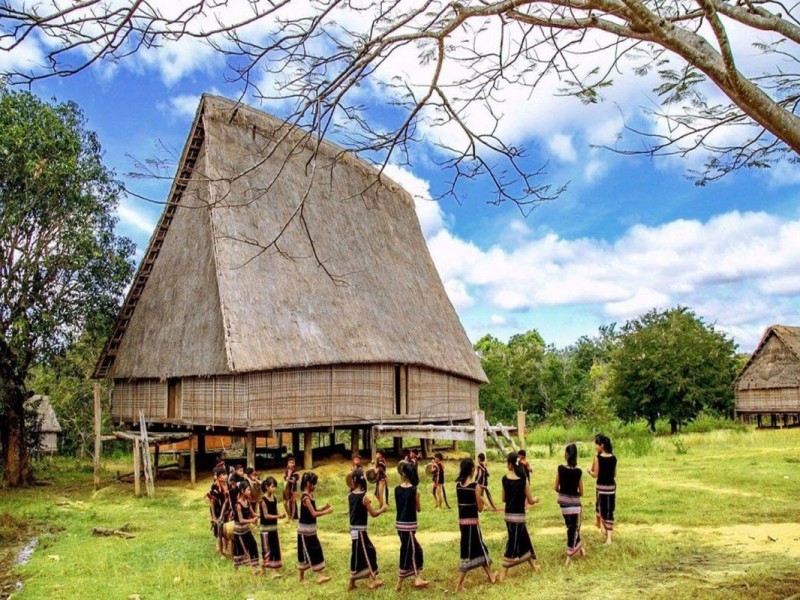
Discover the Central Highlands of Vietnam: An Introduction to Kon Tum
Kon Tum, nestled in the Central Highlands of Vietnam, is a culturally rich province that serves as the crossroads of Indochina. Visitors to this region are often struck by the province’s unspoiled beauty and the warmth of its indigenous communities. It is a place where the rhythms of traditional life remain strong, where the landscapes are dramatic and varied, and where the traces of history—both ancient and recent—are etched into the land. Kon Tum’s unique position at the intersection of three countries—Vietnam, Laos, and Cambodia—has made it a cultural and historical hub, and today, it continues to captivate travelers seeking an authentic Vietnamese experience.
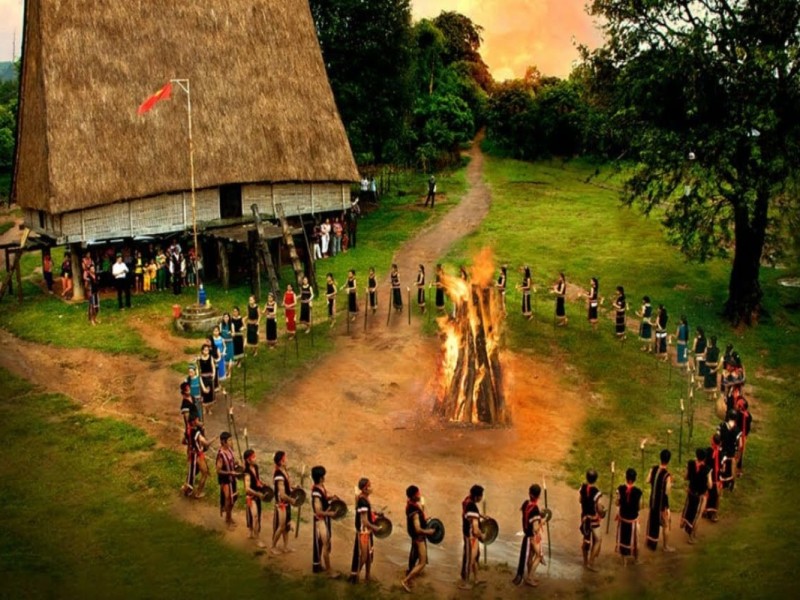
Cultural Significance and History of Kon Tum
Kon Tum's history is as rich as its landscapes. This region has long been home to indigenous groups, particularly the Ba Na people, whose traditions and way of life still shape the cultural fabric of the area. Through centuries of foreign influence, from French missionaries to conflicts during the Vietnam War, Kon Tum has remained resilient, preserving its identity while adapting to the changes brought by history. The blend of indigenous and colonial architecture throughout the region, from wooden churches to communal houses, reflects this deep history.
Ba Na and Indigenous Communities in Kon Tum
The Ba Na people, who have lived in Kon Tum for centuries, are central to the province’s cultural identity. Their traditions, including unique forms of communal living in rong houses (traditional stilt houses), vibrant clothing, and the famous Gong Festival, continue to be celebrated. The Gong Festival, recognized by UNESCO, is a major cultural event where gongs are played in harmony to honor the spirits and ancestors. It is during such events that visitors can witness the close connection the Ba Na people maintain with their land, their gods, and each other. The Ba Na's communal lifestyle and reliance on agriculture have shaped their interaction with Kon Tum’s lush, mountainous terrain, allowing them to thrive in the highlands for generations.
Kon Tum’s Role in Vietnam’s Central Highlands History
Throughout history, Kon Tum has been strategically important due to its location in the Central Highlands. The region became a focus of missionary activity during the French colonial period, which led to the building of religious landmarks like the Kon Tum Wooden Church. Later, during the Vietnam War, Kon Tum played a crucial role as a battleground in the defense of the Central Highlands. The remnants of this historical significance can still be found in various war memorials and sites around the province, giving visitors a glimpse into the turbulent times that shaped modern Vietnam.

Geography of Kon Tum and the Indochina Junction
Kon Tum’s geography is diverse and dramatic, characterized by mountain ranges, rivers, and dense forests. The province sits at the convergence of Vietnam, Laos, and Cambodia, giving it both strategic and cultural significance. Its landscapes, ranging from the tranquil Dak Bla River to the rugged peaks of Chu Mom Ray National Park, are not only beautiful but have played a significant role in shaping the lives and traditions of its indigenous people. Travelers will find that Kon Tum’s natural beauty is best experienced through outdoor adventures, while the region’s rich cultural heritage is revealed in the towns and villages dotting its hills and valleys.
Kon Tum at the Vietnam-Laos-Cambodia Border
One of the most unique features of Kon Tum is its location at the Indochina Junction, where the borders of Vietnam, Laos, and Cambodia meet. This spot, known as the Three-Country Junction, has historical importance as it once marked colonial boundaries. Standing at the junction, travelers can physically straddle three countries at once, a unique experience that highlights Kon Tum’s position as a crossroads in Indochina’s past and present. The surrounding area is also rich in natural beauty, with forests and rivers that mark the meeting point of these three nations.
How Geography Shaped Kon Tum’s Culture and Attractions
The rivers and mountains that define Kon Tum’s geography have played a key role in shaping its culture. The Dak Bla River, for example, has been a lifeline for the people of Kon Tum, providing water for agriculture and a route for trade. Likewise, the forests and mountains have offered both sustenance and protection to the region’s indigenous communities. The isolation of the highlands has allowed for the preservation of traditional ways of life, while the rugged terrain has fostered a culture of resilience and self-sufficiency among the Ba Na people. This connection between the land and the people can be seen in everything from local architecture to the festivals that celebrate the harvest and the spirits of nature.
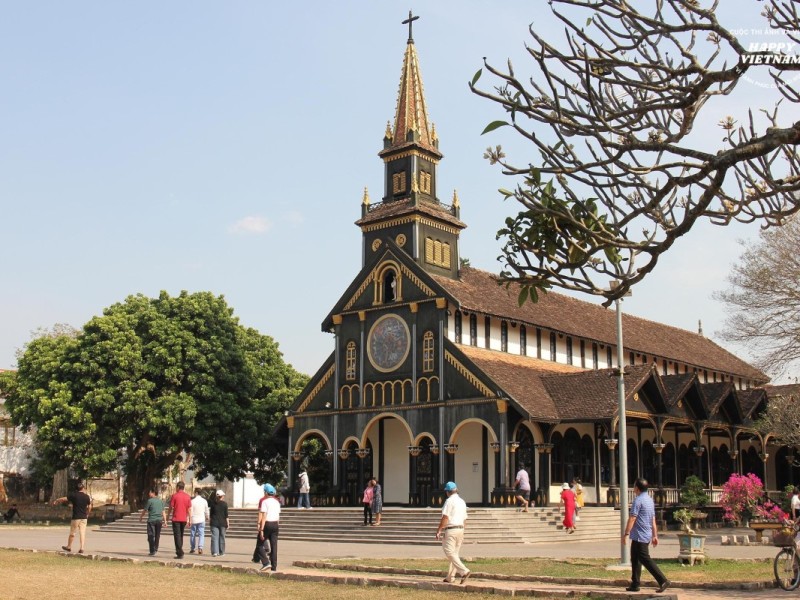
Must-See Places in Kon Tum to Spark Your Curiosity
Kon Tum is home to an array of fascinating sites that reflect both its natural beauty and its rich history. From its iconic wooden churches to the lush landscapes of Mang Den, Kon Tum offers travelers a wealth of experiences. Whether you're interested in history, culture, or nature, Kon Tum’s must-see attractions are sure to spark your curiosity and offer insights into the life and traditions of this remote region.
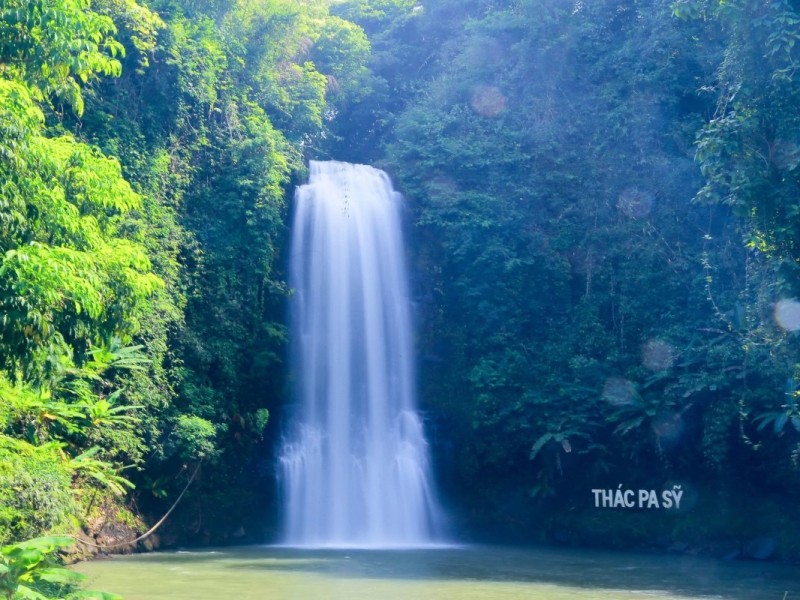
Kon Tum Wooden Church – A Blend of European and Indigenous Architecture
The Kon Tum Wooden Church, built in 1913 and completed in 1918, is one of the most iconic structures in the province. This architectural masterpiece blends Roman-style elements with the stilt house design traditionally used by the Ba Na people. The church stands as a symbol of the cultural exchange between French missionaries and the indigenous community. Its unique design, featuring intricate wood carvings and elevated platforms, is a testament to the craftsmanship and cultural fusion that defines Kon Tum’s identity. Today, the Wooden Church remains an active place of worship and a must-see for travelers.
Historical Background and Unique Design
The Wooden Church was originally built by French missionaries who sought to convert the local Ba Na people to Christianity. Rather than impose European architectural styles wholesale, the missionaries worked with local craftsmen to create a building that would resonate with the local culture. The result is a church that incorporates both Romanesque and indigenous elements, making it a unique example of cultural collaboration. The wooden construction, with its soaring ceilings and intricate carvings, reflects the skills of local artisans, while the elevated design reflects the traditional Ba Na communal house.
Visiting the Wooden Church: Practical Information
Visitors to the Wooden Church are welcome to attend mass or simply admire the architecture. Admission is free, but visitors should dress respectfully, as the church remains an active place of worship. The church is located near the center of Kon Tum, making it easy to access from the main town. Be sure to check the mass schedule if you wish to experience a service, or simply enjoy the peaceful atmosphere of this architectural gem.
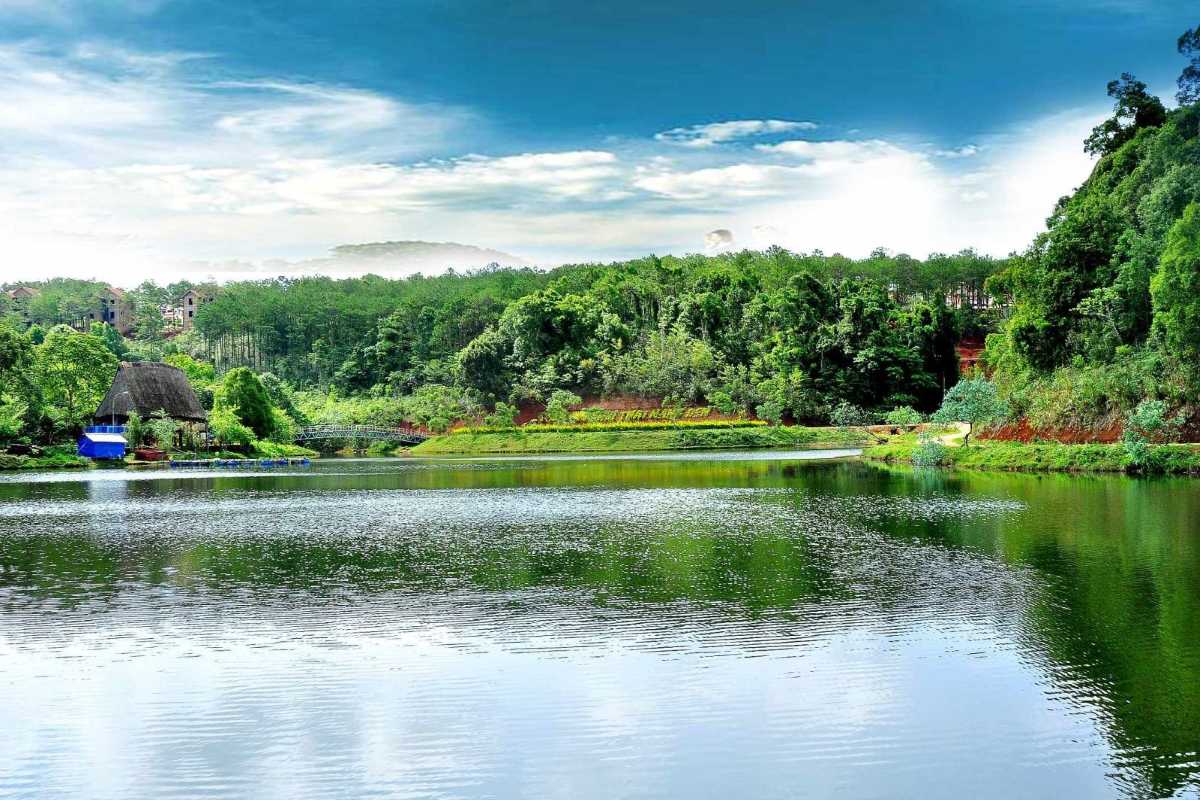
Kon Tum Bishop House – A Cultural Landmark
The Kon Tum Bishop House, built in 1935, is another significant site in the region. Combining both Western and local architectural styles, this structure reflects the colonial history of Kon Tum. The Bishop House also plays a vital role in preserving the religious and cultural heritage of the province, with its small museum housing relics and historical documents that offer insights into the missionary efforts and local responses throughout the centuries. It remains an important cultural landmark for understanding Kon Tum’s historical journey.
Architectural and Cultural Highlights
The Bishop House features a blend of French colonial and indigenous architectural elements, with a spacious veranda, steep roofs, and wooden construction. Inside, visitors can explore a museum that houses artifacts from the missionary era, including religious relics, historical documents, and personal items belonging to early missionaries. The combination of these cultural artifacts with the unique architecture makes the Bishop House a fascinating destination for those interested in both history and design.
Visitor Tips and Cultural Etiquette
When visiting the Bishop House, it’s important to be respectful of the religious and cultural significance of the site. Dress modestly and be mindful of any signage regarding photography or restricted areas. Visitors can take guided tours of the property, which provide deeper insights into the history of the region and the role of the church in the development of Kon Tum.
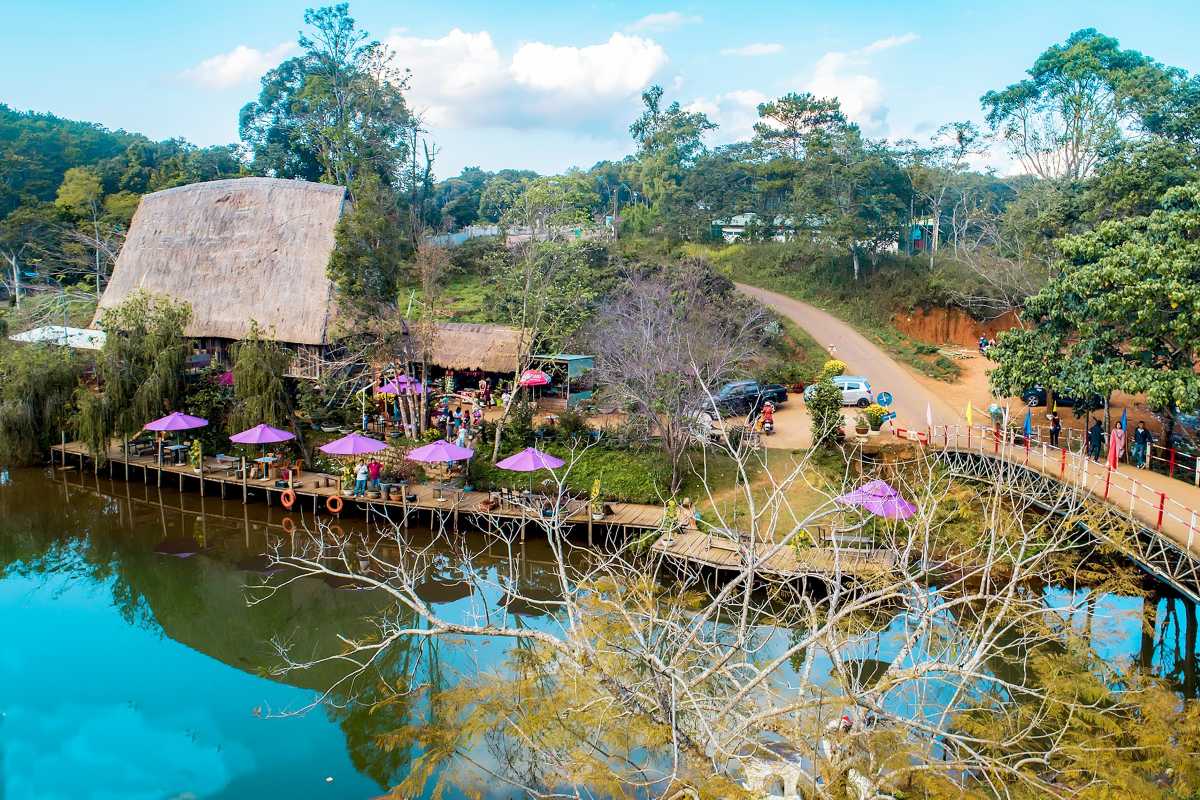
Mang Den Ecotourism Area – The Green Gem of Kon Tum
Nestled in the mountains to the northeast of Kon Tum, Mang Den is often referred to as the "Da Lat of the Central Highlands" due to its cool climate and lush landscapes. This ecotourism area is a haven for nature lovers, offering a wide range of outdoor activities such as hiking, bird-watching, and picnicking in the pine forests. With its tranquil lakes, waterfalls, and cherry blossoms, Mang Den is a must-visit for travelers seeking both adventure and relaxation.
Nature Trails and Pine Forests in Mang Den
Mang Den’s nature trails wind through dense pine forests, offering visitors the chance to explore the region’s natural beauty on foot. The cool, fresh air makes hiking a pleasure, and the trails are suitable for all fitness levels. Along the way, travelers will encounter a variety of bird species, as well as other wildlife that call this region home. For those who prefer a more relaxed experience, the pine forests provide a peaceful backdrop for a picnic or leisurely stroll.
Key Attractions: Lakes, Waterfalls, and Cherry Blossoms
The beauty of Mang Den is not limited to its forests. The area is also home to several stunning lakes and waterfalls, which offer opportunities for boating, fishing, and simply enjoying the serene surroundings. Each spring, the cherry blossoms burst into bloom, turning Mang Den into a sea of pink that rivals some of the world’s most famous cherry blossom destinations. Whether you’re exploring the lakes or taking in the seasonal flowers, Mang Den offers something for every nature lover.
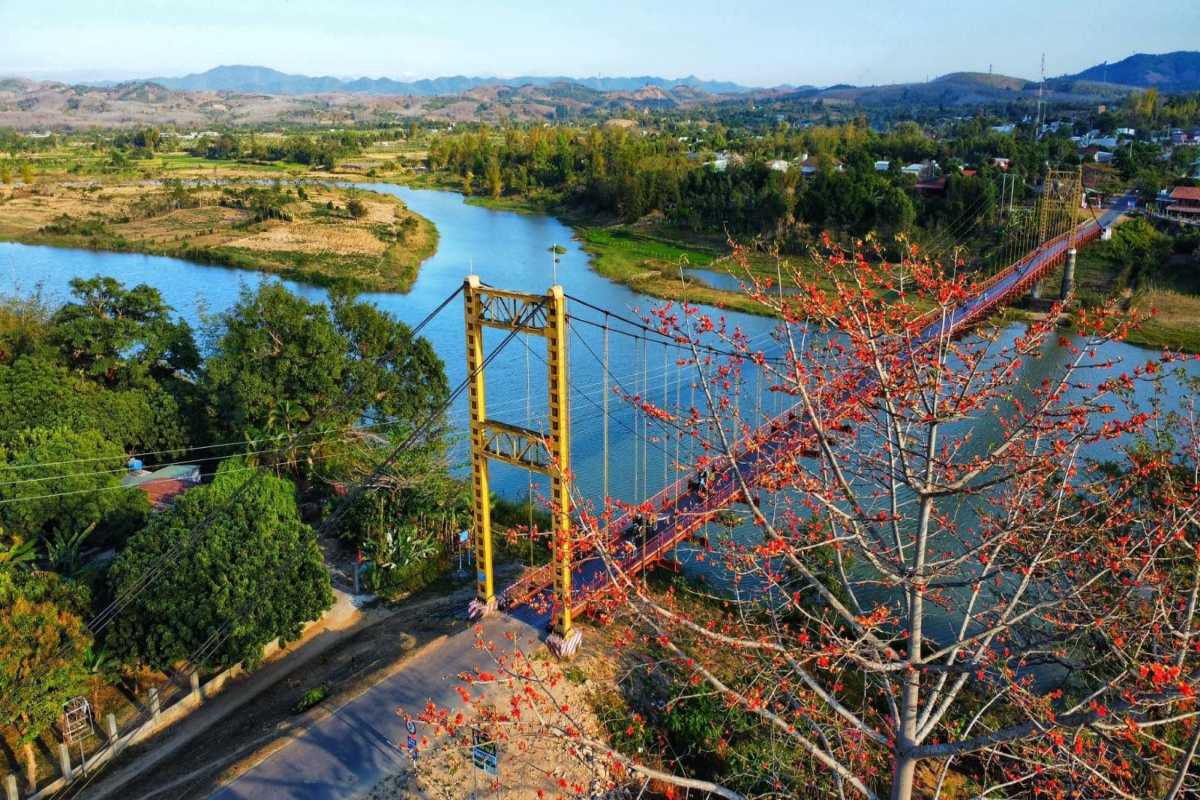
Exploring Kon Tum’s Cultural and Natural Attractions
Kon Tum offers travelers a rich mix of cultural and natural attractions, providing an authentic glimpse into the region’s indigenous communities and biodiverse landscapes. Whether it’s trekking through vast national parks or exploring local festivals that celebrate centuries-old traditions, Kon Tum is a treasure trove of experiences for nature lovers and culture seekers alike. With its deeply rooted history, vibrant cultural life, and unspoiled natural beauty, Kon Tum stands as a prime destination for eco-tourism and cultural immersion in Vietnam’s Central Highlands.

Chu Mom Ray National Park: A Biodiversity Haven
Chu Mom Ray National Park is one of Vietnam’s most important ecological sanctuaries, encompassing a diverse range of flora and fauna across a landscape of mountains, forests, and rivers. Visitors to the park will find themselves immersed in one of the country’s most biologically rich environments, where the natural world remains largely undisturbed. The park not only serves as a haven for wildlife but also offers an unparalleled experience for eco-tourists and adventure travelers looking to explore Vietnam’s wild side.
Flora and Fauna of Chu Mom Ray National Park
Chu Mom Ray is home to over 2,000 species of plants and more than 700 species of animals, making it one of the richest biodiversity hotspots in the region. The park’s dense forests are filled with towering hardwoods, rare orchids, and medicinal plants that have been used by indigenous peoples for generations. Animal species range from small primates and colorful bird species to larger mammals like elephants and tigers. The park’s conservation efforts have focused on protecting these endangered species while allowing eco-tourism to thrive in a way that minimizes human impact on the environment.
Trekking Routes and Guided Tours
Trekking in Chu Mom Ray is a journey through dense jungles, up challenging mountain paths, and along serene rivers. The park offers a range of trekking routes suitable for all levels, from easy walks that explore the forest floor to multi-day hikes that take visitors deep into the mountains. Local guides provide valuable insights into the region’s ecosystem, sharing stories about the flora and fauna, and highlighting the delicate balance that sustains the park’s biodiversity. For adventure seekers, there’s nothing quite like trekking through Chu Mom Ray’s untouched landscapes, knowing that you’re following in the footsteps of conservationists and explorers alike.
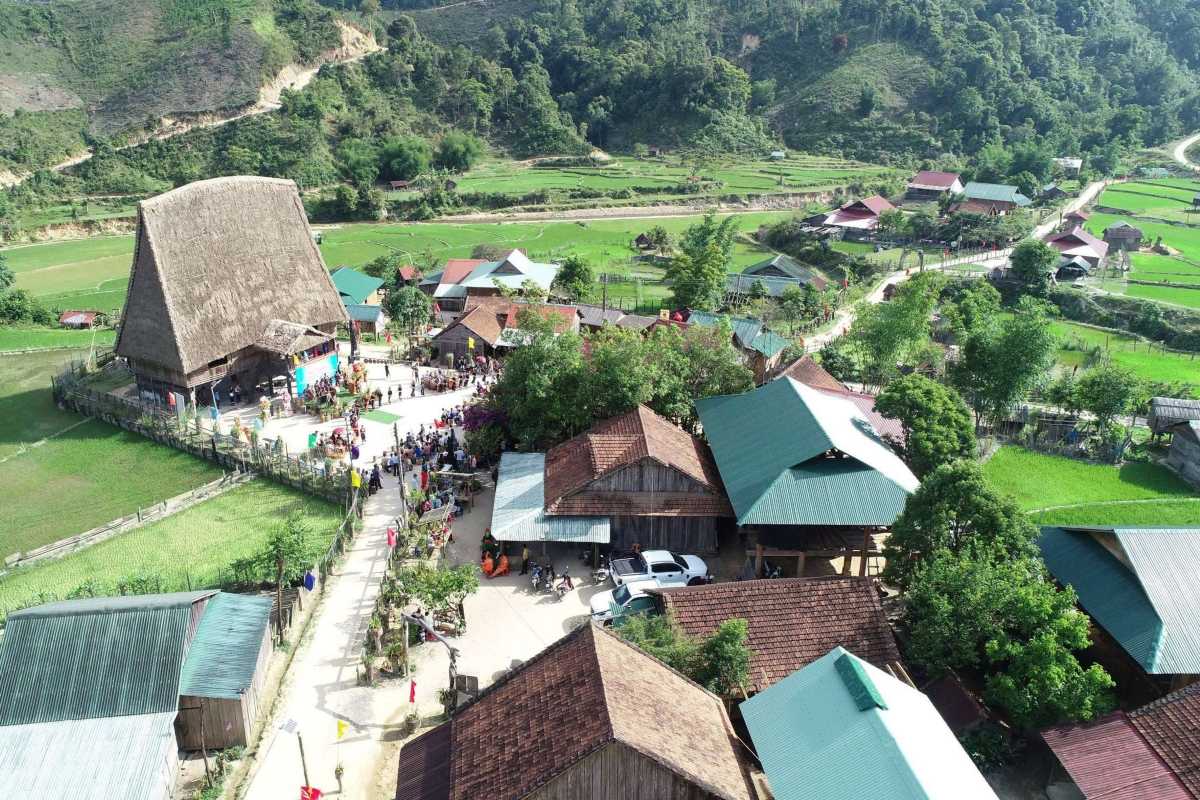
Dak Bla River: A Lifeline of Kon Tum
The Dak Bla River is much more than a scenic waterway—it’s the lifeblood of Kon Tum’s local villages. Winding its way through the highlands, the river supports agriculture, provides transportation routes, and serves as a vital resource for the Ba Na people who live along its banks. For visitors, the Dak Bla offers not only a stunning natural vista but also an opportunity to engage with local culture, whether through river-based activities or by visiting the villages that rely on its waters.
Cultural Importance of Dak Bla River to Local Villages
The Dak Bla River is central to the agricultural and cultural life of Kon Tum’s indigenous communities. Along its banks, traditional Ba Na villages have thrived for generations, with rice paddies and vegetable farms nourished by the river’s waters. The river’s significance extends beyond the practical, however—it holds spiritual importance as well, playing a central role in local festivals and rituals. For the Ba Na, the river is a symbol of life, sustaining not only their crops but also their cultural heritage.
Kayaking and River Cruises in Dak Bla
For travelers seeking adventure, the Dak Bla River offers excellent opportunities for kayaking and river cruises. Kayaking along the calm stretches of the river provides a peaceful way to take in the lush landscapes that surround Kon Tum, while more adventurous travelers can tackle the river’s faster sections for a bit of thrill. River cruises, on the other hand, offer a leisurely experience, often accompanied by cultural performances and meals prepared by local villagers. Both options give visitors a unique perspective on the region, allowing them to enjoy Kon Tum’s natural beauty from the water.

Indochina Junction: Where Three Countries Meet
One of the most intriguing geographical features of Kon Tum is the Indochina Junction, where the borders of Vietnam, Laos, and Cambodia converge. This point is not only a physical marker but also a symbol of the region’s historical and cultural ties to Indochina. For travelers, visiting the junction offers a rare opportunity to stand in three countries at once while reflecting on the interconnected histories of Southeast Asia.
Historical Importance of the Vietnam-Laos-Cambodia Border
The Indochina Junction has long been a point of political and cultural significance. During the French colonial period, this area was part of the larger Indochina region under French control, and the convergence of these three nations became a strategic and symbolic location. In more recent history, the junction has witnessed moments of conflict and cooperation, serving as a reminder of the complex relationships between these neighboring countries. For visitors, the junction is not just a geographical curiosity but a place to reflect on the region’s shared history.
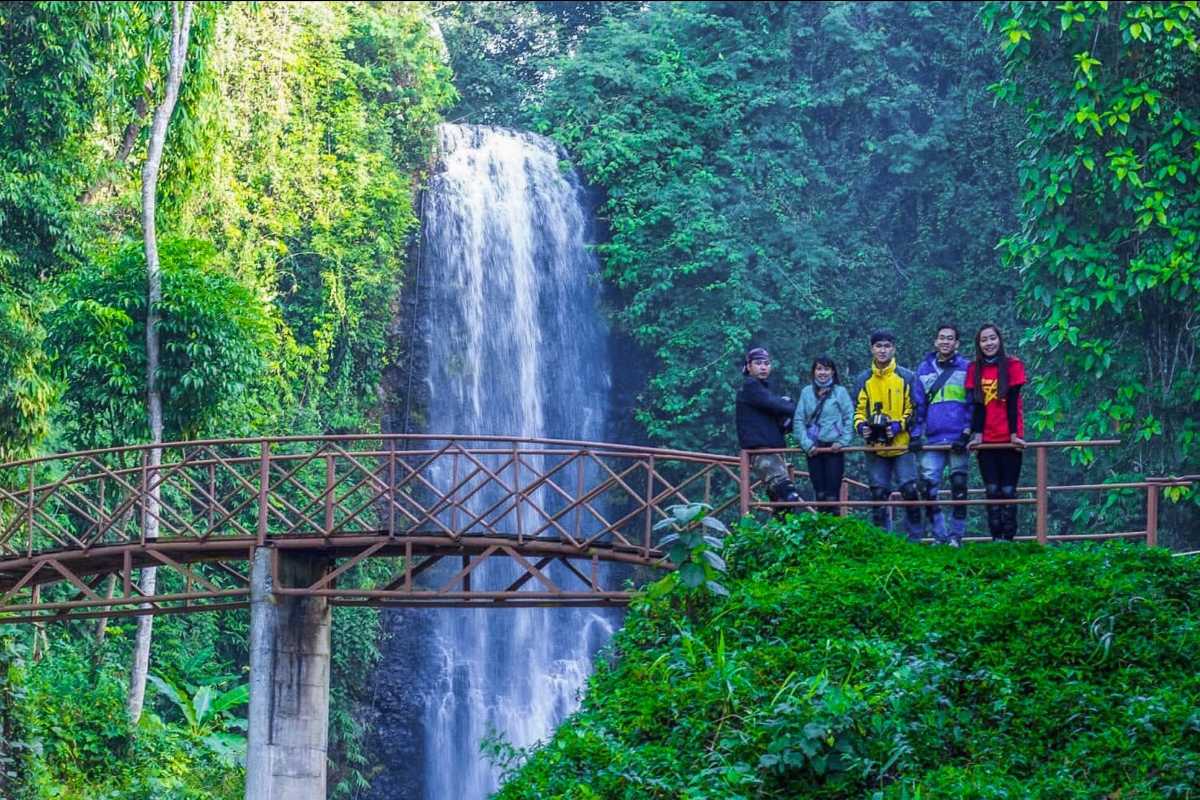
The Coffee Culture of Kon Tum
The Central Highlands of Vietnam, including Kon Tum, is known for its coffee cultivation, with vast plantations that produce some of the finest coffee in the country. Coffee is not just an economic driver for the region—it’s a cultural experience that travelers can partake in by visiting coffee farms, learning about traditional cultivation methods, and enjoying freshly brewed cups in local cafés. For coffee lovers, Kon Tum offers an immersive experience that highlights the journey from bean to cup in one of the world’s top coffee-producing regions.

Exploring Coffee Plantations in the Central Highlands
The high-altitude plantations of Kon Tum are ideal for growing robusta coffee, which thrives in the cool, misty climate of the Central Highlands. Visitors can tour these plantations to learn about the coffee-growing process, from planting and harvesting to roasting and brewing. As you wander through the coffee fields, you’ll gain an appreciation for the skill and labor that goes into producing each cup, while also enjoying the stunning natural beauty of the highlands.
History of Coffee Cultivation in Kon Tum
Coffee was first introduced to the Central Highlands by French colonists in the late 19th century, and since then, the region has become a key player in Vietnam’s coffee industry. Today, Kon Tum’s coffee plantations continue to thrive, producing high-quality robusta beans that are prized both locally and internationally. The French influence can still be seen in the traditional methods used on many plantations, where coffee is hand-picked and sun-dried to preserve its rich flavor.
Popular Coffee Varieties and Café Culture
In Kon Tum, coffee is more than just a drink—it’s a way of life. The region is known for its robusta beans, but visitors can also sample unique varieties like egg coffee, a creamy and rich brew that’s a favorite in Vietnam. Local cafés offer a cozy atmosphere where you can enjoy a cup of coffee while soaking in the highland scenery. Whether you’re sipping coffee in a small village or a bustling town, you’ll experience the strong café culture that has become an integral part of daily life in the Central Highlands.
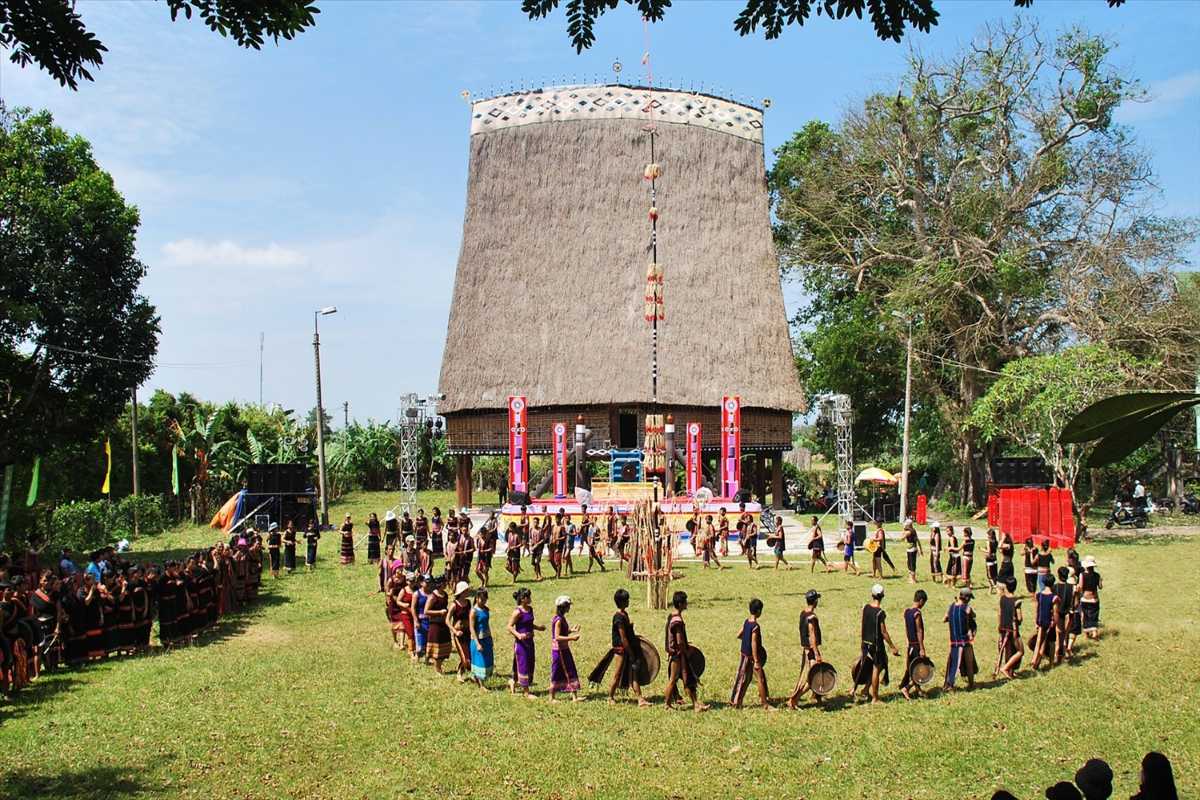
Local Festivals: Experience the Traditions of Kon Tum
Kon Tum’s festivals are vibrant expressions of the region’s indigenous culture, offering travelers the chance to witness and participate in traditional celebrations that have been passed down through generations. These festivals are deeply tied to the agricultural cycle, the changing seasons, and the spiritual beliefs of the local people. Attending one of these festivals is a highlight for visitors, as it provides a window into the community’s values and way of life.
Gong Festival and Ba Na Cultural Celebrations
The Gong Festival is one of the most important cultural events in Kon Tum, celebrating the music, dance, and spiritual practices of the Ba Na people. Recognized by UNESCO as an Intangible Cultural Heritage, the festival centers around the use of gongs, which are believed to connect the physical and spiritual worlds. Villagers perform intricate dances to the rhythm of the gongs, offering prayers and thanks to their ancestors and gods. For travelers, the Gong Festival is a truly unique experience that showcases the richness of Kon Tum’s cultural heritage.
The New Rice Festival: A Traditional Ba Na Harvest Celebration
The New Rice Festival is another important event in Kon Tum, marking the end of the harvest season and celebrating the earth’s bounty. During this festival, the Ba Na people come together to give thanks to the gods for a successful harvest, with rituals that include the offering of rice and other crops, traditional dancing, and feasting. Travelers who attend the New Rice Festival will witness a deeply spiritual celebration that reflects the close relationship between the Ba Na people and the land they cultivate.
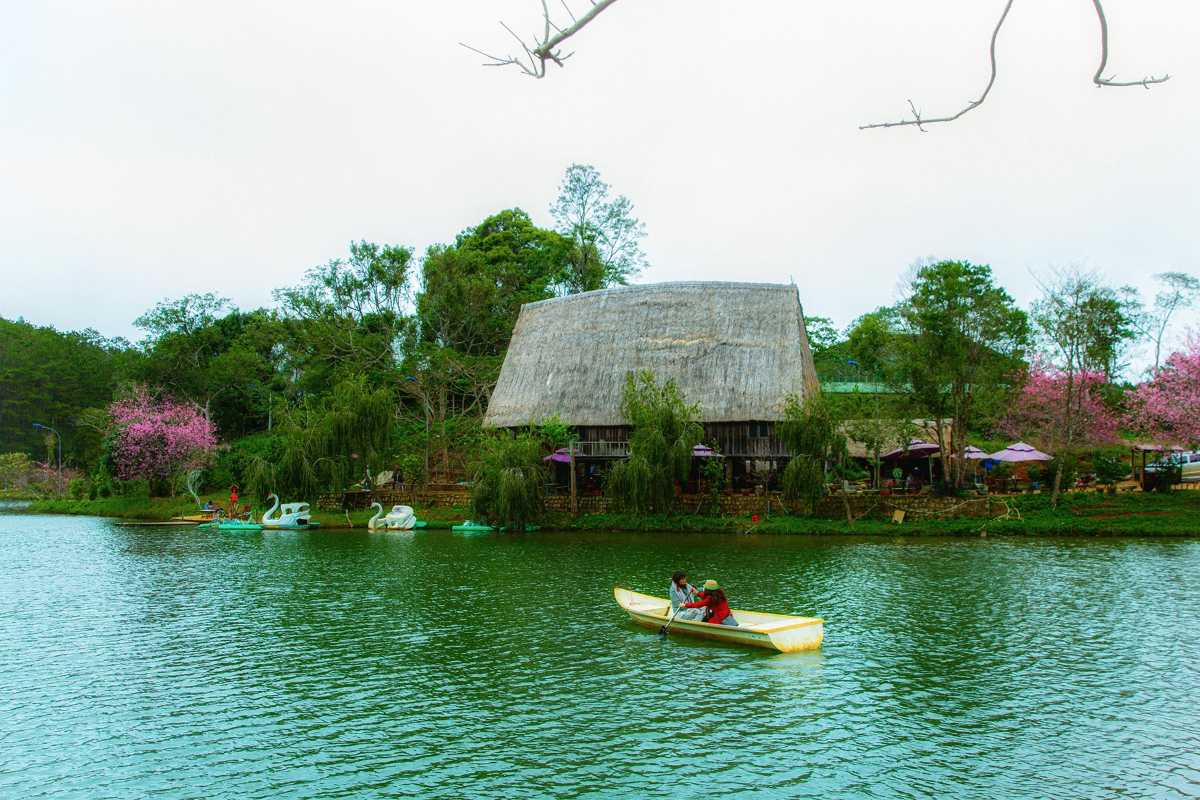
Why Kon Tum Should Be Your Next Destination
Kon Tum's blend of rich history, awe-inspiring landscapes, and vibrant cultural experiences positions it as a destination that beckons adventure seekers, history enthusiasts, and travelers looking to immerse themselves in authentic Vietnam. Whether you're trekking through untouched nature reserves or participating in centuries-old festivals, Kon Tum promises a journey that goes far beyond the beaten path, offering rare, intimate glimpses into a region filled with traditions, natural wonders, and unforgettable moments.
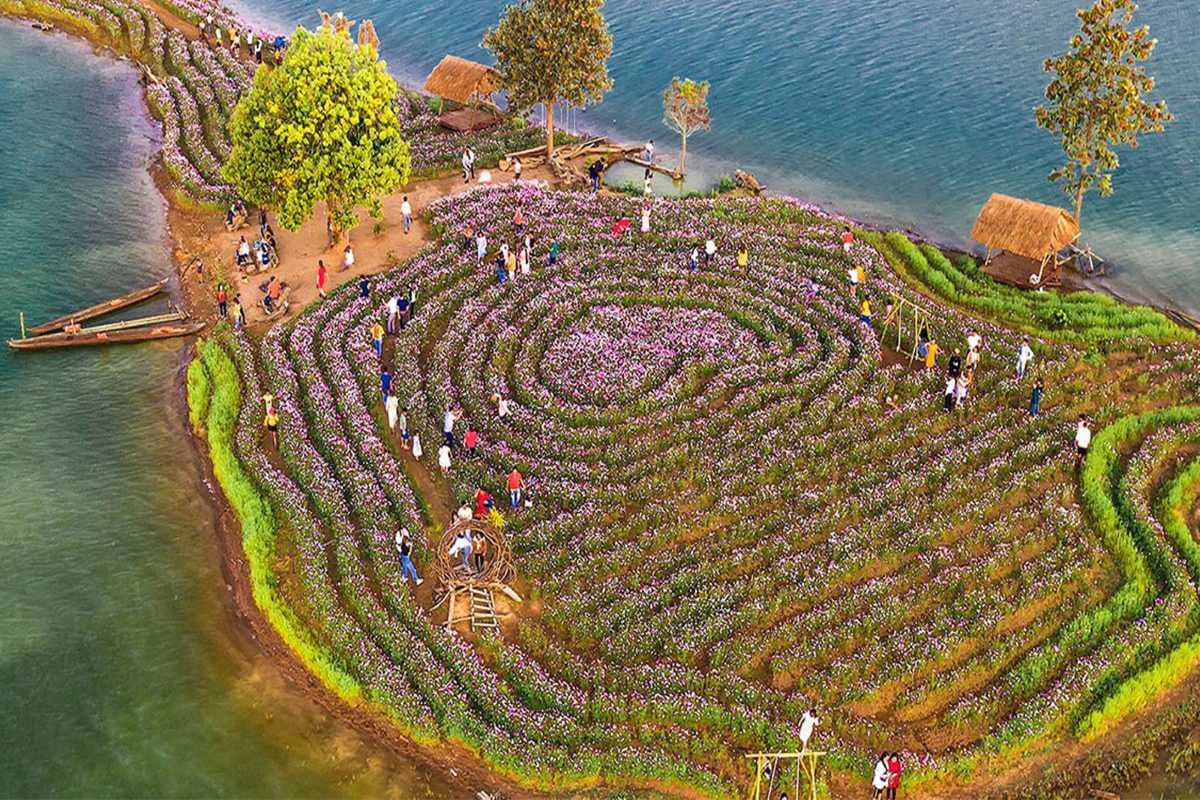
Unforgettable Experiences in Kon Tum’s Natural Landscapes
The landscapes of Kon Tum are breathtaking in their diversity. From mist-covered mountains to dense forests, tranquil rivers, and expansive rice fields, the region offers a spectacular variety of outdoor experiences. Whether you crave the adrenaline of adventure sports or seek peaceful moments in nature’s embrace, Kon Tum’s natural beauty is sure to leave a lasting impression.
Trekking and Adventure Sports in Kon Tum
Kon Tum is a haven for adventure lovers, offering various trekking routes that range from easy trails to challenging expeditions. The most notable trek is up Ngoc Linh Mountain, a majestic peak standing over 2,600 meters tall. As one of the highest points in the Central Highlands, Ngoc Linh provides hikers with stunning panoramic views and the opportunity to explore unique ecosystems along the way. For the adrenaline seekers, Mang Den offers zip-lining through lush forests, mountain biking, and rock climbing. The dry season, from November to April, is the ideal time to enjoy these outdoor activities, as the clear skies and moderate temperatures create perfect conditions for exploration.
Relaxing in the Pine Forests of Mang Den
While Kon Tum offers plenty of adventure, it also provides spaces for rest and relaxation. Mang Den, often referred to as the "Second Da Lat," is an idyllic retreat with its cool climate and expansive pine forests. This peaceful area allows visitors to take leisurely walks or bicycle rides through the forest, enjoying the quiet beauty of nature. The crisp mountain air, serene lakes, and picturesque waterfalls provide the perfect backdrop for unwinding from the bustle of everyday life. For those seeking tranquility, Mang Den is the ideal place to disconnect, recharge, and reconnect with nature.
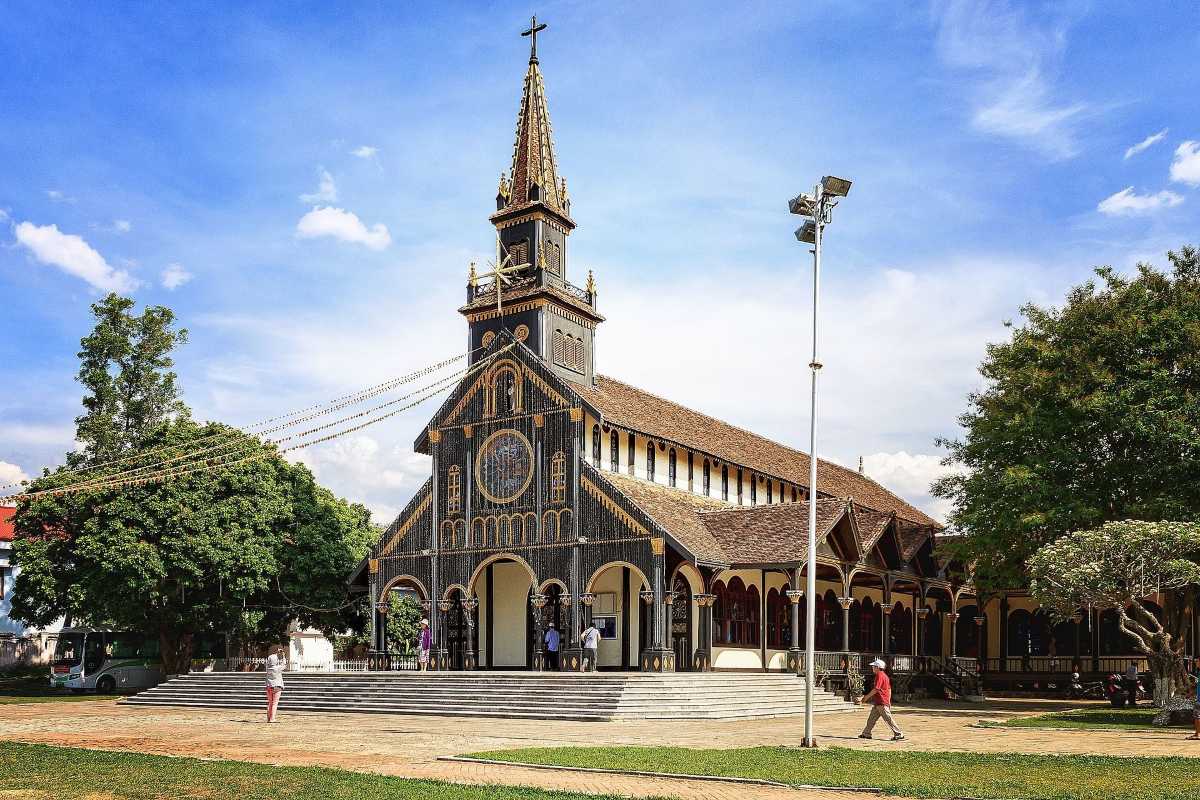
Unique Cultural Experiences in Kon Tum
Kon Tum’s rich cultural heritage is deeply intertwined with the traditions of its indigenous communities. One of the most remarkable aspects of visiting the region is the opportunity to engage with the Ba Na people, an indigenous group that has preserved its customs for centuries. From village tours to festivals, Kon Tum offers travelers a window into the daily life, spirituality, and cultural expressions of the region’s ethnic minorities.
Indigenous Ba Na Villages and Cultural Tourism
A visit to Kon Tum is not complete without exploring its Ba Na villages. These indigenous communities offer travelers a rare opportunity to learn about the customs, traditions, and way of life that have been passed down through generations. The rong houses—distinctive communal stilt houses with steeply pitched roofs—are the heart of Ba Na culture, serving as spaces for meetings, rituals, and celebrations. Tours of these villages allow visitors to participate in daily activities such as weaving, farming, and cooking, providing an immersive experience into the life of the Ba Na people. Beyond the physical experience, these visits foster a deep connection between travelers and the indigenous culture, highlighting the importance of preserving these ancient traditions.
Participating in Traditional Festivals in Kon Tum
Kon Tum is renowned for its vibrant festivals, which are a reflection of the spiritual and agricultural life of its people. Among the most significant is the Gong Festival, recognized by UNESCO as an Intangible Cultural Heritage of Humanity. During this festival, villagers perform traditional dances to the rhythmic sounds of gongs, believed to connect the physical and spiritual worlds. Another essential celebration is the New Rice Festival, which marks the end of the harvest season. During this festival, the Ba Na people give thanks to the gods for a bountiful harvest through offerings, rituals, and communal feasts. Attending these festivals allows travelers to experience the heart of Ba Na culture, witnessing the profound connection between the community and the land they cultivate.
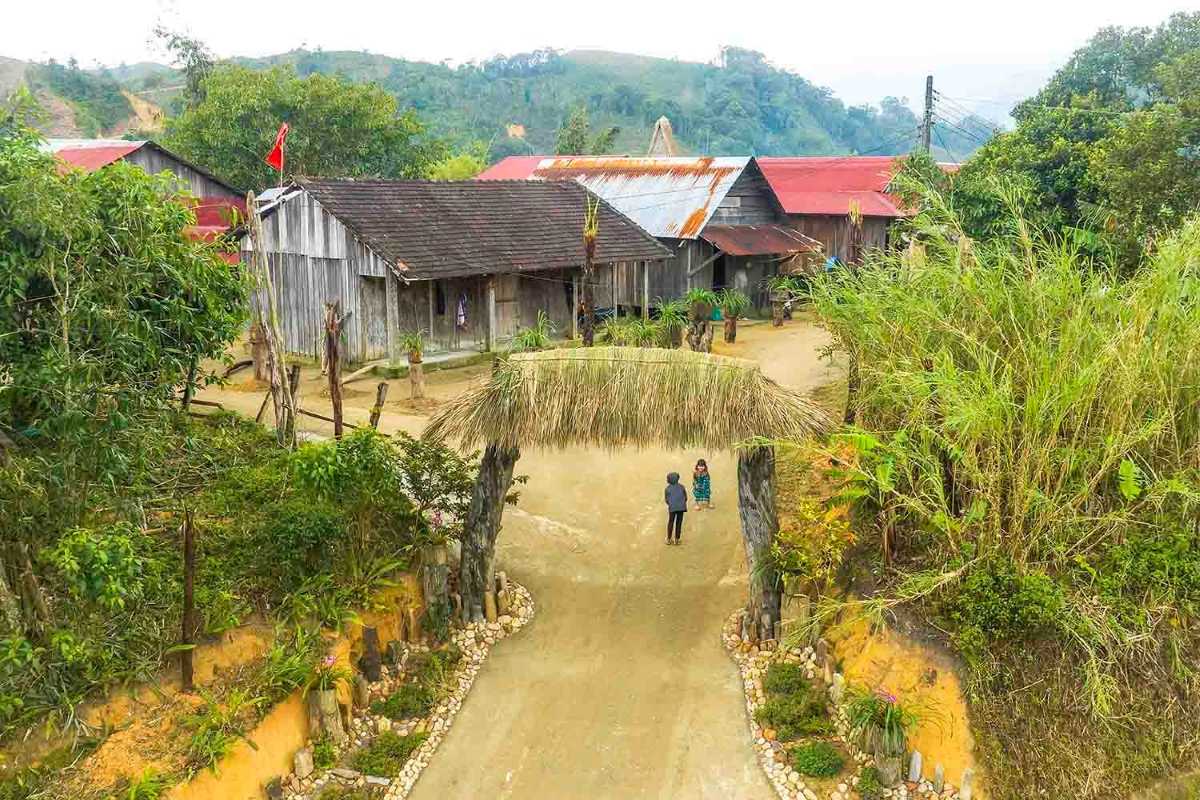
Best Times to Visit Kon Tum for an Ideal Experience
Choosing the right time to visit Kon Tum can greatly enhance your experience, whether you are looking to immerse yourself in the region’s natural beauty or join in its vibrant cultural celebrations. Kon Tum offers unique experiences throughout the year, from its breathtaking cherry blossom season to its lush green landscapes during the rainy months.
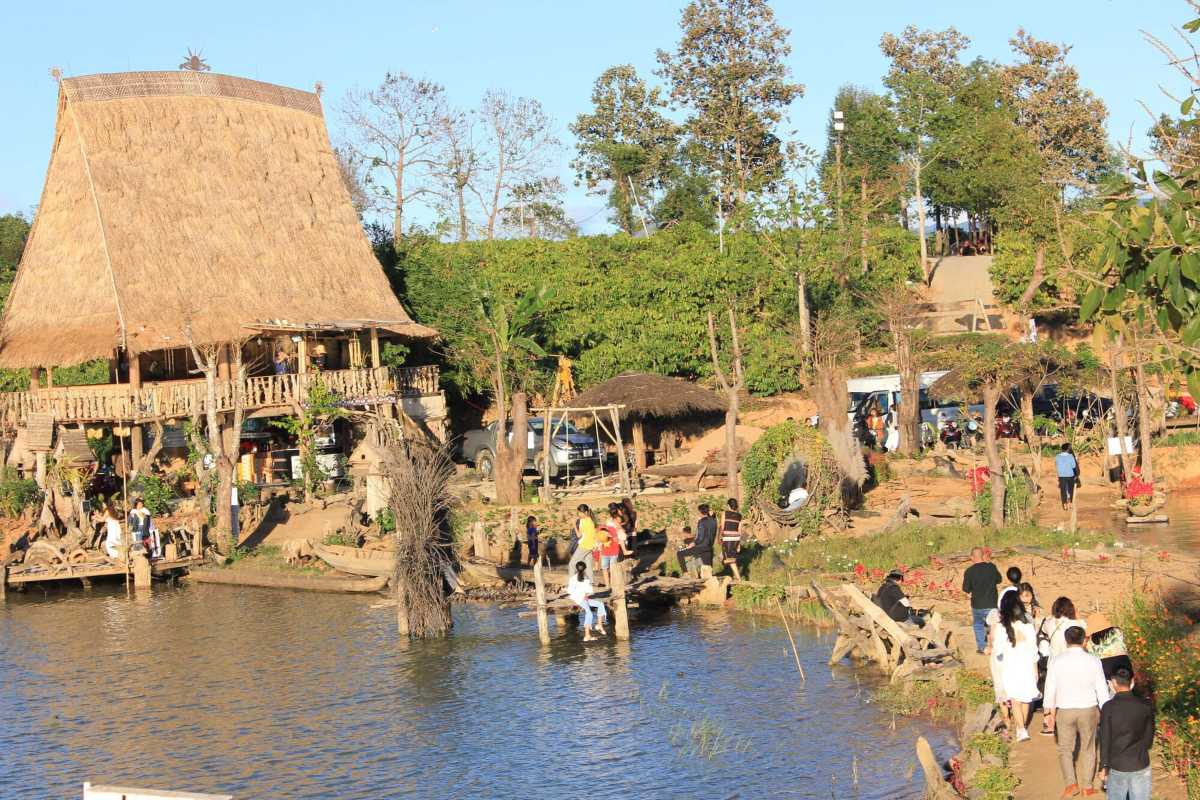
Visiting Kon Tum During the Cherry Blossom Season
One of the most visually stunning times to visit Kon Tum is during the cherry blossom season, which typically occurs in March. During this time, Mang Den and other parts of Kon Tum come alive with delicate pink blossoms that blanket the landscape. This season is particularly popular among nature photographers and travelers seeking picturesque scenery. Mang Den’s Cherry Blossom Festival is a highlight of the season, featuring cultural performances, food stalls, and the perfect opportunity to experience the region’s natural beauty at its peak. For those planning a trip during this period, booking accommodations in advance is highly recommended due to the influx of visitors.

Best Time for Adventure Activities
Kon Tum’s adventure activities are best enjoyed during the dry season, which runs from November to April. During this time, the weather is ideal for outdoor pursuits, including trekking, kayaking, and mountain climbing. Clear skies, moderate temperatures, and dry conditions make it the perfect time to explore Kon Tum’s national parks, rivers, and mountain ranges without the risk of heavy rain. Travelers looking to enjoy Kon Tum’s eco-tourism opportunities, such as trekking in Chu Mom Ray National Park or kayaking along the Dak Bla River, will find this period offers the most pleasant conditions for such adventures.
Dry Season: Ideal for Trekking and Outdoor Adventures
The dry season not only offers favorable weather for outdoor activities but also provides access to some of the more challenging trekking routes that may be difficult to navigate during the rainy season. Trekking in Ngoc Linh Mountain or exploring the biodiversity of Chu Mom Ray National Park is especially rewarding during these months, as the clear skies allow for breathtaking views from the mountain peaks, and the dry paths make for safer and more enjoyable hikes.
Rainy Season: Discover the Lush Greenery of Kon Tum
While the rainy season (May to October) may deter some travelers, it offers a different kind of beauty to those who venture to Kon Tum during this time. The region’s landscapes become more vibrant, with waterfalls at their fullest and the rice fields glowing in bright green. Nature photographers, in particular, will appreciate the dramatic scenery created by the rain. Though the rainy season brings heavier precipitation, it’s also an ideal time for eco-tourism, offering travelers a chance to experience Kon Tum’s lush greenery in all its glory.

Plan Your Visit to Kon Tum Now
Planning your trip to Kon Tum is the first step toward experiencing this culturally rich and naturally stunning region. Whether you're traveling for its lush landscapes or to immerse yourself in the local traditions, Kon Tum has something for everyone. Ensuring a smooth visit means understanding transportation options, choosing the right accommodations, and booking the best tours to maximize your adventure.
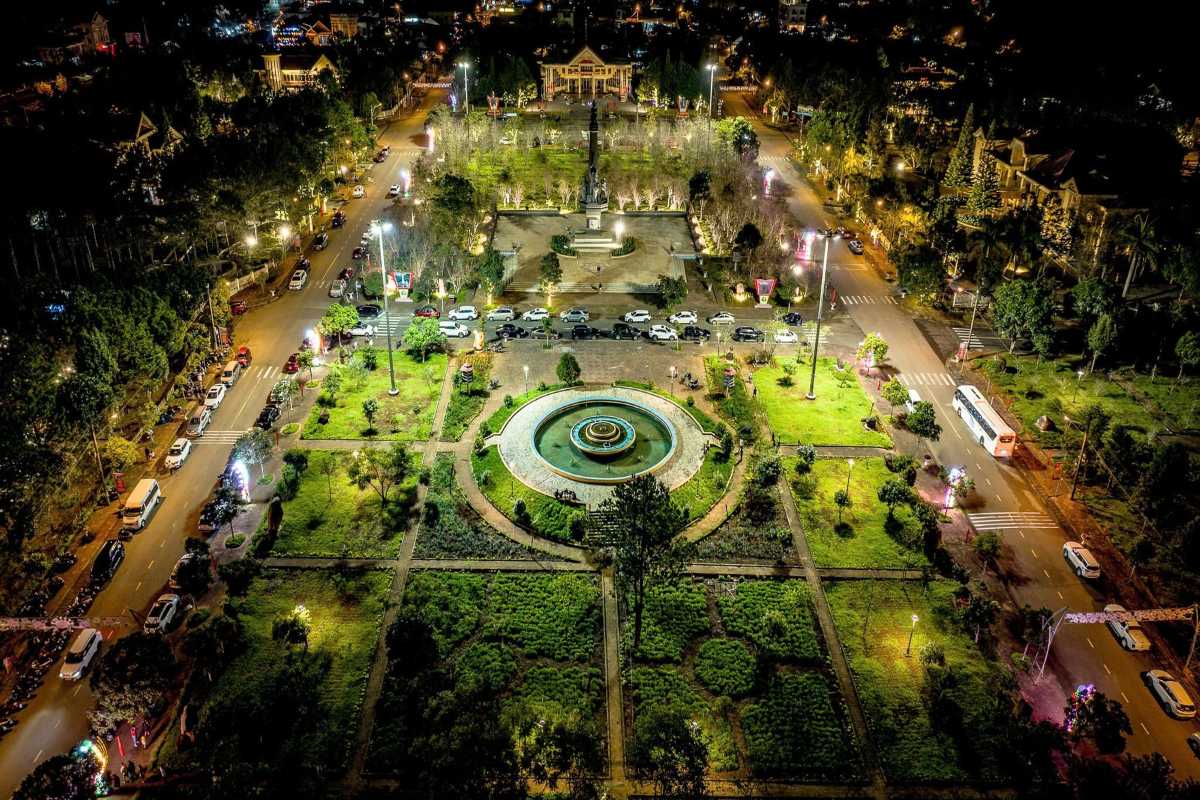
How to Get to Kon Tum
Reaching Kon Tum is convenient thanks to multiple transportation options that cater to different budgets and travel preferences. Whether you're flying in from other Vietnamese cities or traveling by bus, planning your journey in advance can help ensure a smooth trip.
Travel Options: Buses, Flights, and Taxis
Travelers can reach Kon Tum via a variety of transportation modes. The closest airport to Kon Tum is Pleiku Airport, located about 50 kilometers away. Several domestic flights arrive here from major cities like Ho Chi Minh City, Hanoi, and Da Nang, making it the most convenient option for long-distance travelers. Once you land in Pleiku, a quick bus or taxi ride will take you to Kon Tum in just under an hour. For budget travelers, overnight sleeper buses from cities like Ho Chi Minh City, Da Nang, or even Hanoi provide a cost-effective option, though the trip takes longer. Buses are typically comfortable, and the long ride offers travelers a chance to enjoy the changing landscape as they move toward the Central Highlands.
Transportation Tips for Visitors
Navigating Kon Tum is fairly straightforward, thanks to the availability of motorbikes for rent, a popular choice among travelers seeking flexibility. Renting a motorbike allows you to explore the countryside, visit remote villages, and discover hidden gems at your own pace. Taxis are also readily available and are a good option for shorter trips within the town. However, public transportation like local buses can be limited in rural areas, so it's best to plan ahead, especially if you're venturing into the more remote parts of the region. Be mindful of local traffic rules, and remember that Vietnam’s roads can be challenging, so safety should always be a priority.
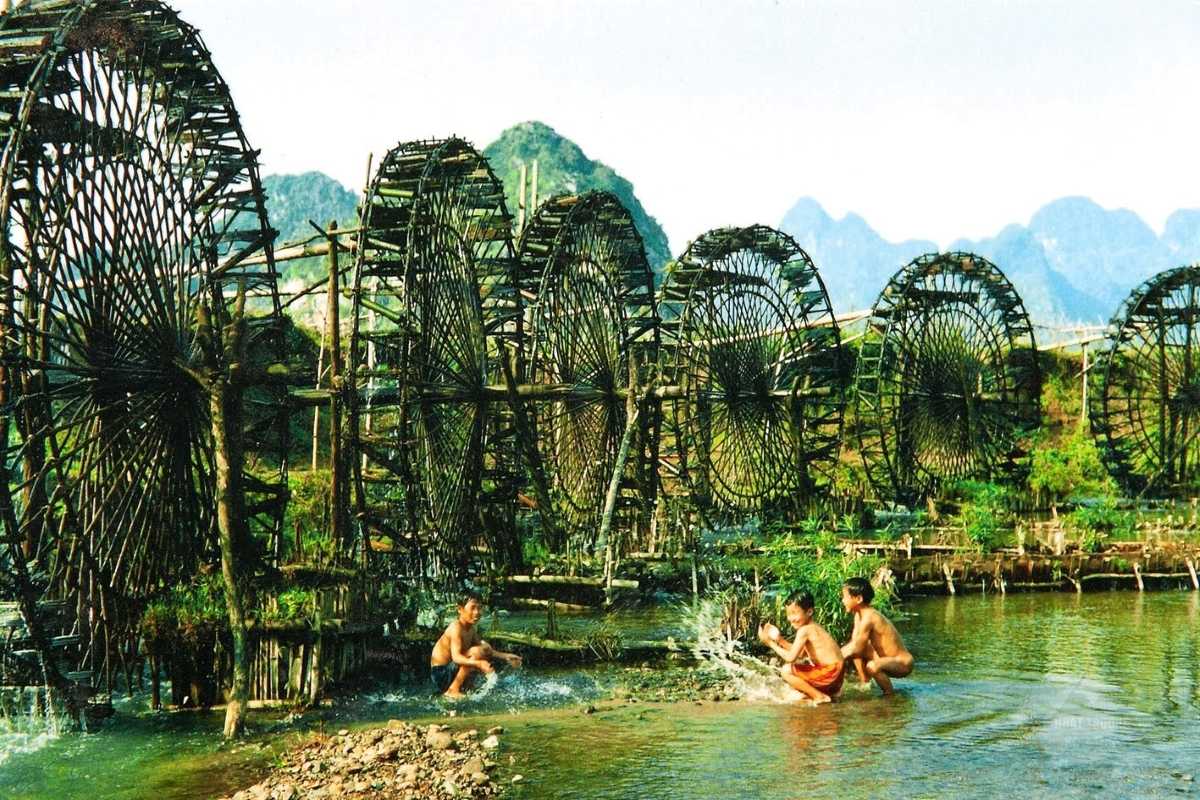
Where to Stay in Kon Tum
Finding the right place to stay in Kon Tum depends on your preferences and budget. Whether you’re looking for an authentic cultural experience through a homestay or prefer the comforts of a luxurious resort, Kon Tum has accommodations to suit every traveler.
Best Budget Hotels and Homestays in Kon Tum
For budget-conscious travelers, homestays provide an authentic and affordable accommodation option. Many homestays are located in Ba Na villages, allowing visitors to stay with local families and immerse themselves in the culture. These stays often include meals prepared by the family and the opportunity to participate in daily activities like farming or weaving. Additionally, there are several budget hotels in Kon Tum City, offering basic but comfortable rooms, ideal for travelers who plan to spend most of their time exploring the region rather than relaxing indoors.
Luxury Accommodation Options for Families and Couples
For those seeking a bit more luxury, Mang Den offers high-end resorts nestled in the beautiful pine forests. These resorts are particularly popular with families and couples looking for a peaceful retreat. Private bungalows, spa services, and scenic views of the surrounding landscapes make for a perfect getaway after a day of exploration. Families can enjoy spacious accommodations, while couples can opt for romantic packages that include activities like guided forest walks and private dining experiences amidst nature.
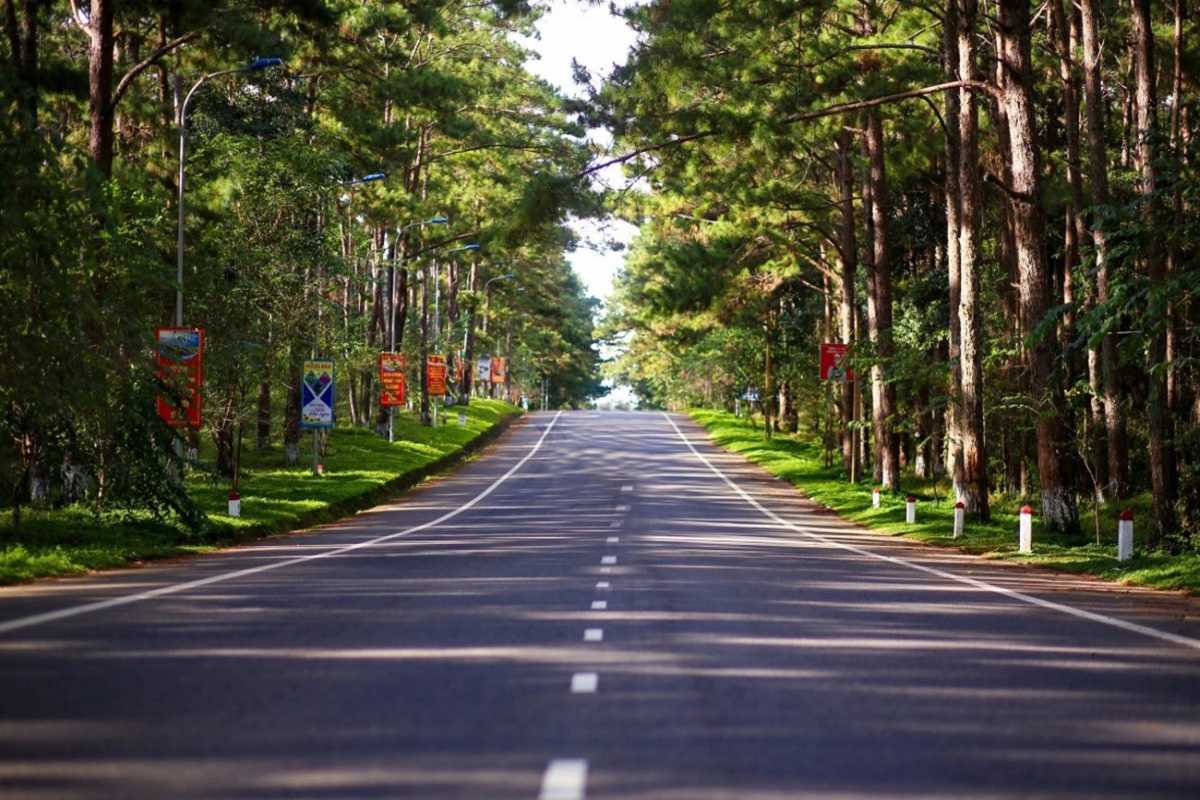
Book Your Kon Tum Adventure
Once you've sorted out your accommodations and travel plans, it’s time to book your Kon Tum adventure. From cultural tours to adventure-packed trekking experiences, the region offers a wide range of activities that cater to both nature lovers and cultural enthusiasts.
Adventure Tours and Eco-Tourism Packages
Eco-tourism is at the heart of Kon Tum's offerings. Various adventure tours are available, allowing you to explore the rich biodiversity of the region while contributing to its sustainable development. Local tour operators provide packages that include trekking in Chu Mom Ray National Park, visits to indigenous villages, and eco-friendly stays in nature lodges. These packages often come with expert local guides who provide insight into the flora and fauna, as well as the cultural significance of the areas you’ll visit. Whether you're looking for a multi-day trek through the mountains or a relaxing nature retreat, there’s something for every type of traveler.
River Cruises and Cultural Village Tours
For a more leisurely experience, consider booking a river cruise along the Dak Bla River, which runs through Kon Tum. These cruises often include stops at historical sites and offer meals prepared by local communities. Many cruises also feature cultural performances, giving travelers an intimate glimpse into the local traditions. If you're interested in cultural immersion, opt for a tour of one of the region's indigenous villages, where you can participate in traditional ceremonies or learn about the Gong Festival—a UNESCO-recognized cultural heritage.

Why Kon Tum is the Ultimate Destination for Your Next Adventure
Kon Tum is an extraordinary destination that seamlessly blends cultural heritage, natural beauty, and adventure. From the serene pine forests of Mang Den to the vibrant traditions of the Ba Na people, Kon Tum offers a truly immersive experience that caters to all types of travelers. Whether you're seeking a peaceful retreat or an action-packed adventure, Kon Tum promises unforgettable memories. The region’s rich history, unique festivals, and eco-tourism opportunities ensure that every visit is filled with discovery and excitement. Now is the perfect time to plan your journey to Kon Tum and experience the wonders of this hidden gem in Vietnam’s Central Highlands. Start organizing your trip today and embark on a journey of a lifetime.
Nguyễn Việt Hưng
Faqs
Kon Tum is known for its rich indigenous culture, stunning natural landscapes, and historical significance in Vietnam’s Central Highlands.
The province is famous for the Ba Na ethnic group’s traditions, including their unique rong houses and the UNESCO-recognized Gong Festival. Visitors are drawn to the region’s pristine pine forests, the scenic Dak Bla River, and the diverse biodiversity of Chu Mom Ray National Park. Kon Tum also holds historical landmarks such as the iconic wooden church that blend colonial and indigenous architecture.
- Rich cultural heritage with vibrant Ba Na communities
- Unique natural beauty including pine forests and mountain parks
- Important historical sites from colonial and wartime periods
Explore Kon Tum to experience authentic cultural immersion alongside breathtaking nature.
You can reach Kon Tum by air, bus, or road from major Vietnamese cities like Ho Chi Minh City, Hanoi, and Da Nang.
The nearest airport is Pleiku Airport, about 50 kilometers from Kon Tum, with flights connecting to major hubs. From Pleiku, taxis or buses can take you to Kon Tum city. For budget travelers, overnight sleeper buses operate between Kon Tum and cities like Ho Chi Minh City or Da Nang, offering a cost-effective though longer journey. Renting a motorbike locally provides flexible exploration options within the province.
- Fly to Pleiku Airport, then travel by road to Kon Tum
- Overnight buses from Ho Chi Minh City and Da Nang
- Local transport includes taxis, motorbikes, and limited buses
Plan your route in advance to match your travel style and schedule.
The best time to visit Kon Tum is during the dry season from November to April and during the cherry blossom season in March.
Dry season weather offers clear skies and moderate temperatures, ideal for trekking, outdoor adventures, and exploring national parks. March brings stunning cherry blossoms in areas like Mang Den, attracting nature lovers and photographers. Although the rainy season (May to October) brings lush greenery and full waterfalls, heavy rains may limit outdoor activities.
- November to April for trekking and adventure activities
- March for cherry blossom festivals and scenic blooms
- Rainy season offers vibrant landscapes but can be wet and slippery
Choose your travel time based on preferred activities and weather conditions.
Most cultural sites in Kon Tum, including the Wooden Church, have free entry, while some nature reserves and eco-tourism areas charge modest fees.
Cultural landmarks like the Kon Tum Wooden Church are open to visitors at no cost, encouraging exploration of local heritage. National parks such as Chu Mom Ray may require entrance fees or guided tour bookings to support conservation efforts. Eco-tourism zones like Mang Den might include access charges for certain activities or facilities.
- Free entry to many historical and cultural sites
- Possible fees for national parks and eco-tourism areas
- Tour packages often include all entrance costs
Check specific site details before visiting to plan your budget accordingly.



